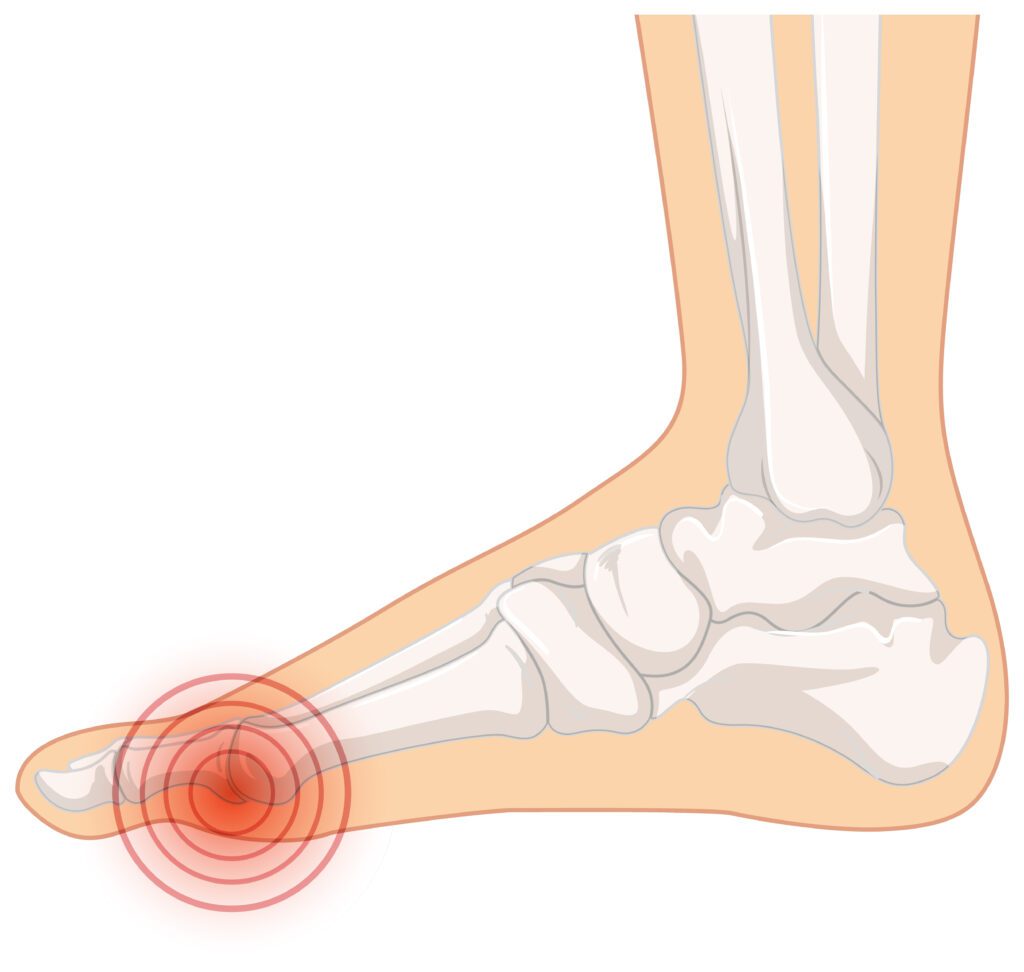Contrary to the name, the metatarsophalangeal (MTP) joints are very small joints located about two centimeters near the webs of the toes. It is the connecting link between the toes and the bones in the central part of the foot. Metatarsal phalangeal joint (MTP) sprain, also known as turf toe, happens when ligaments under the big toe get overextended. Bowers and Martin first outlined the term” turf toe” in 1976 after studying soccer players. They observe that this sprain occurs mostly in sportspersons playing on tough artificial surfaces. With the growing gym junkie lifestyle, MTP joint sprain has become very common and can happen to anyone. So, the six things you should know about metatarsophalangeal joint sprain are:
Causes and symptoms of MTP Joint sprain
MTP joint plays a vital role in the stabilization and balance of the body during push-offs, changing directions, and weight-bearing exercises. Too much bending of the big toe upward or backward beyond normal limits leads to over-stretching or tearing away of the ligaments. The leading causes of MTP joint sprain can be attributed to lite flexible footwear, wearing high heels, artificial rigid surfaces, and activities demanding repetitive loading of MTP joints with push-off and change of direction. Some other causes of MTP joint injury are a prior MTP joint injury, foot pronation, flattening of the MTP joint, a decreased number of studs in the shoe, and MTP degenerative joint disease.
Symptoms of MTP joint sprain are pain in the big toe area, swelling, inflammation, limited range of motion of the big toe, and stiffness.
Three stages of MTP joint sprain
Based on the severity of the sprain, MTP joint sprain can be categorized into three stages:
Stage 1
Stage 1 refers to a sprain with mild swelling, pain, and tenderness. The ligament around the joint gets overstressed but is not torn away. There is a lack of mobility and stiffness at the base of the toe.
Stage 2
This condition refers to severe swelling, inflammation, and partial tearing away of ligaments. The movement of the big toe becomes difficult and painful.
Stage 3
It involves tearing and damaging of ligaments around the big toe with severe pain and swelling. Moving the big toe becomes very difficult or impossible.
Who are at risk of getting MTP joint sprain
A study found that 36 out of 80 professional football players had experienced MTP joint sprain in their sports career. Apart from soccer players, this is common among sportspersons in basketball and wrestling. Among females, those wearing high heels and professional dancers are at high risk of getting MTP joint sprain.
Treatment and recovery time
Left untreated metatarsophalangeal joint sprain can permanently decrease the mobility range of the big toe and cause osteoarthritis. Recovery time for the sprain is difficult to predict as it varies from person to person. Depending on the severity of the injury, treatment, and recovery time for stages one, two, and three are as follows:
Grade one sprain can be treated without surgery at home or under medical supervision. The sprain usually goes away in one week by using anti-inflammatory drugs and following the RICE protocol: rest, ice compression, and elevation. Grade one patients can be involved in non-weight-bearing athletic activities like bicycling with stiffed shoes.
Grade two patients, apart from anti-inflammatory drugs and RICE protocol, require at least two weeks of rest before returning to regular activity with accessories like walking boots and a turf toe plate for support for at least the next week.
Grade three patients require two months of rest in non-surgical cases and six months for rehabilitation. Surgery is required if there are no recovery symptoms or improvement after a long duration of immobilization.
Prevention
Though getting turf toe is unavoidable in case of accidents. In other cases, it can be prevented in many ways as;
Sports persons and athletes should wear shoes that protect the toe from overbending and provide stability, gives better support, and rigidity in the toe area. Using inserts in the shoes prevents the toe from overbending. Stretching and warm-up exercises should be done before sports, as it makes ligaments and muscles flexible. Female dancers should avoid high heels during the performance. High heels should, in general, be avoided by females as they badly affect ankle joints, knees, and backbone, besides becoming susceptible to MTP joint sprain.
Home remedies
As stage three MTP joint sprain requires intensive medical intervention and care, only stages one and two can be treated at home. There are some home remedies available for this:
Use of baking soda
Baking soda, being anti-inflammatory, is a very effective home remedy for any foot sprain. Take half a cup of baking soda in one bucket of warm water and soak the sprained foot in this water for 10 minutes. Baking soda also helps in reducing the swelling of the big toe.
Olive oil, sesame oil, and clove oil
Olive oil and sesame oil are excellent muscle relaxants, and clove oil has antiseptic and anti-inflammatory properties. Massaging with two to three teaspoons of sesame oil and olive oil mixed with a few drops of clove oil twice daily for five to seven minutes mildly over the affected area considerably reduces the pain and inflammation.
Taping
Taping turf toe with the most common size tape of 1 inch or 11/2 inch restricts big toe movement and provides support. It also helps in pain relief and gives protection. Care should be taken while taping, and it should not be done with much pressure to cut off blood circulation in that area.
FAQ
How long does it take for an MTP joint sprain to heal?
For grade one patients MTP joint sprain gets healed up within one week with proper use of anti-inflammatory drugs and by following RICE(rest, ice, compression,and elevation) protocol. For grade two patients it can take up to two weeks before returning to regular activity with accessories like walking boots and for grade three patients at least six months of rehabilitation is required in non surgical cases.
What are the home remedies for MTP joint sprain?
Soaking the sprained foot in baking soda water for 10 minutes, massaging with olive oil sesame oil and clove oil open the area add taping the big toe with common size tape of 1 inch or 11/2 inch are some of the home remedies for MTP joint sprain or turf toe.
I hope this information was helpful!
If you want to read more of our content, please visit our blog
Featured Image by brgfx on Freepik
DISCLAIMER – The tips provided are for informational purposes only and do not constitute professional advice.




